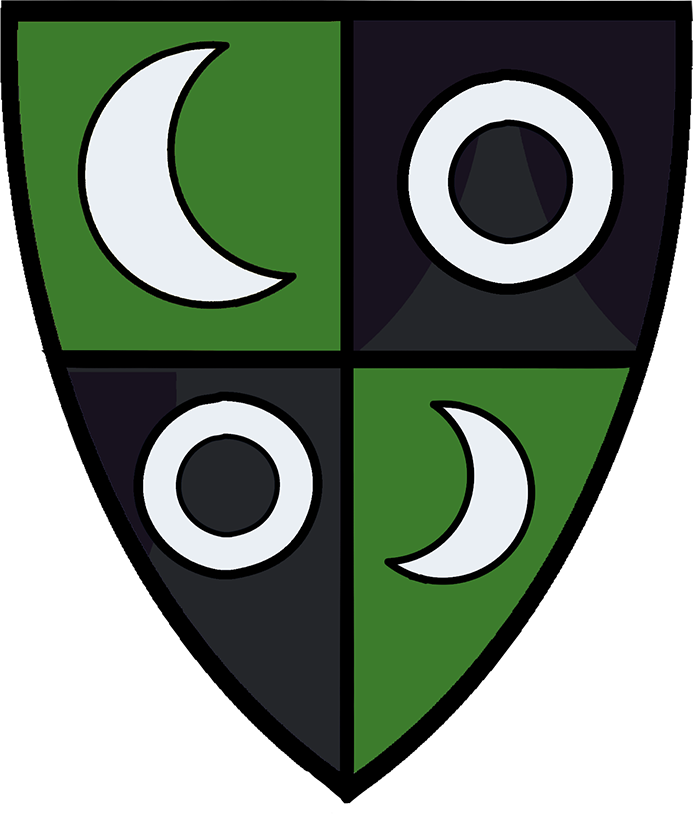| House | Holdings | Note | |
|---|---|---|---|
 | House Tuveren | County of Owl Rock | Currently holds the Duchy of Estia |
 | House Beckett | County of Covenant | |
 | House Dawnstar | County of Greystone | |
 | House Blaise | County of Cottenhorn | |
| House Arbrintirel | Barony of Roslake | Elvish family | |
 | House Villencourt | Barony of Goldshore | Halfling family |
 | House Keswick | Barony of Arastfjord | |
 | House Ashworth | Barony of Whitport | |
 | House Cassaro | Barony of Northcross | |
 | House Delacroix | Unlanded | Halfling family |
| House Sharvir | Unlanded | Elvish family | |
 | House Breckenridge | Unlanded | |
 | House Cornelii | Unlanded | |
 | Clan Greatbraid | Jarldom of Myrknes | Dwarven clan |
 | Clan Dragonbrand | Chiefdom of Kundamar | Dwarven clan |
| Clan Truthweaver | Chiefdom of Jotunnadal | Dwarven clan | |
| Clan Ambermane | Chiefdom of Vargavakt | Dwarven clan |
Generations of marriages and scheming has created a complex web of relations, feuds and friendships between the upper crust of Estian society. Some of the titles were awarded while the Empire ruled, but most were created to award those who had been instrumental to the League's founding.
The noble families spend their time vying for wealth and positions of power, primarily on the Estian Council. Some have turned their focus to the patronage of artists, athletes, and gladiators. Being in the good graces of a powerful noble is a post desired by many, as the very name of one's patron can open many doors and coffers.
The family trees presented for each House are somewhat simplified, omitting cadet branches and lesser known members of the house for clarity. They also usually omit children that bear the name of their other parent's house.
Titles
The ranks of nobility can be hard to understand for an outsider, but it is quite simple. A noble always has a liege of higher rank, to whom they pay taxes to (collected from lower-ranked nobles, who in turn collect from the people).
Estian noble titles (except for Duke of Estia) follow absolute primogeniture, meaning that the oldest child inherits the title regardless of gender. If a holder of a title dies without children, the title goes to the nearest living relative. As a rule, nobles who marry do not change their names (nor are they given their spouse's title). Noble children are usually given the name of the parent with the most senior claim to a title.
New titles, both landed and unlanded, can be created by the Estian Council with a majority vote. The Speaker has a veto on any such vote, but rarely needs to use it, as neither the noble faction nor the republican faction wants more nobles to share power with.
Duke/Duchess
The highest title is duke/duchess. No family holds a permanent ducal title. The Speaker of the Council is awarded the title of Duke of Estia for their tenure, and all the Counts swear fealty to them. The taxes collected by the Duke of Estia goes to run the government of the League.
Count/Countess
The second highest title is count/countess. A county title is usually based in a major city and holds large areas of land. Dwarven clans instead use the word Jarl for this title.
Baron/Baroness
This is the lowest land-holding title. A barony usually consists of a smaller town or a large village and its surrounding land. In dwarven society, this title is equal to that of Chieftain.
Lord/Lady
This title is given to the head of house of a noble family that does not hold land, or trueborn children of a head of house. If there is need to distinguish between the two variants, the style Lord/Lady Master is sometimes used. There are several families who are noble, but through marriage or some other reason have lost their land holdings, making Lord the highest title they can use.
Lord or Lady can also be used as a generic noble title, usually by lowborn people who might not be sure of the proper protocol.
Knight
Addressed as Sir (regardless of gender), this is the lowest noble title. It given to those who serve in knightly orders, or are sworn protectors of other noble families. The Lodge of the Roses is one such order, and several of the higher officers of the Purple Legion are also given this title.